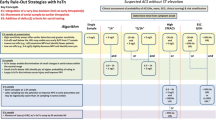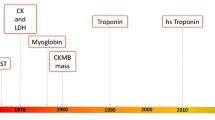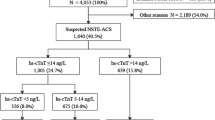Abstract
The 4th edition of the Universal Definition of Myocardial Infarction (MI) recommends measurement of cardiac troponin (cTn) T or I for the diagnosis of MI due to their absolute cardiac tissue specificity. In this MI definition, values exceeding the 99th percentile of a healthy reference population distinguish between detectable troponin due to physiological cell turnover as opposed to pathological myocardial injury. In clinical routine, high-sensitivity (hs) troponin assays that allow earlier diagnosis of MI and detection of myocardial injury that would have escaped detection due to the lower sensitivity of previous assay generations are increasingly used. While the 2015 European Society of Cardiology (ESC) guidelines already recommend a re-testing of cTn after 3 h, if an hs-cTn assay is available, faster protocols that reassess hs-cTn after 60–120 min are increasingly performed, since these protocols allow faster patient disposition, increase discharge rates from the emergency department (ED), and are at least as safe as the standard protocol for the guidance of discharge after rule-out. However, decision cut-offs are lower than the 99th percentile and concentration change criteria depend on the individual hs-cTn assay and protocol used. The following article provides an overview of the recommendations of the 4th universal MI definition as well as the current 2015 ESC guidelines on cTn and other potential biomarker candidates for patients presenting with suspected acute coronary syndromes. Limitations and areas of controversy are discussed.
Zusammenfassung
In der vierten Version der „Universellen Infarktdefinition“ wird die Messung von kardialem Troponin T (cTnT) oder I (cTnI) für die Diagnose des akuten Myokardinfarkts empfohlen, da kardiale Troponine gewebespezifisch sind und den myokardialen Schaden zuverlässig anzeigen. Das 99. Perzentil einer gesunden Referenzpopulation dient dabei der Unterscheidung zwischen dem Vorliegen einer Herzmuskelnekrose im Rahmen der physiologischen Zellregeneration und einer abnormen Myokardschädigung. In der klinischen Routine werden zunehmend hochsensitive (hs) Troponinassays eingesetzt, mit denen sich ein Myokardinfarkt früher diagnostizieren lässt und Myokardschäden erkannt werden können, die in der Vergangenheit aufgrund der geringeren Sensitivität älterer Assays übersehen worden wären. Die European Society of Cardiology (ESC) empfiehlt in ihren Leitlinien schon seit 2015 eine Wiederholungsmessung von hs-cTn nach 3 h, soweit ein entsprechender Test verfügbar ist. Immer öfter werden aber schnellere Protokolle mit Testwiederholung nach 60–120 min angewendet, da sie eine schnellere Patientendisposition ermöglichen, die Rate der Notaufnahmeentlassungen steigern und eine mindestens so sichere Orientierung bezüglich der Entlassung nach Infarktausschluss bieten wie das Standardprotokoll. Allerdings liegen die diagnostischen Cut-offs unter dem 99. Perzentil und die Konzentrationsänderungen sind je nach hs-cTn-Assay und Protokoll sehr unterschiedlich. Der vorliegende Beitrag gibt eine Übersicht über die Empfehlungen der vierten „Universellen Infarktdefinition“ und der aktuellen ESC-Leitlinien aus dem Jahr 2015 im Hinblick auf cTn und weitere mögliche Biomarkerkandidaten bei Verdacht auf ein akutes Koronarsyndrom. Es werden Limitationen und kontroverse Punkte diskutiert.



Similar content being viewed by others
References
Thygesen K, Alpert JS, White HD et al (2012) Third universal definition of myocardial infarction. Eur Heart J 33:2551–2567
Roffi M, Patrono C, Collet JP et al (2016) 2015 ESC Guidelines for the management of acute coronary syndromes in patients presenting without persistent ST-segment elevation: Task Force for the Management of Acute Coronary Syndromes in Patients Presenting without Persistent ST-Segment Elevation of the European Society of Cardiology (ESC). Eur Heart J 37:267–315
Amsterdam EA, Wenger NK, Brindis RG et al (2014) 2014 AHA/ACC Guideline for the Management of Patients with Non-ST-Elevation Acute Coronary Syndromes: a report of the American College of Cardiology/American Heart Association Task Force on Practice Guidelines. J Am Coll Cardiol 64:e139–e228
Collinson PO, Heung YM, Gaze D et al (2012) Influence of population selection on the 99th percentile reference value for cardiac troponin assays. Clin Chem 58:219–225
Giannitsis E, Kurz K, Hallermayer K et al (2010) Analytical validation of a high-sensitivity cardiac troponin T assay. Clin Chem 56:254–261
Keller T, Zeller T, Peetz D et al (2009) Sensitive troponin I assay in early diagnosis of acute myocardial infarction. N Engl J Med 361:868–877
Reichlin T, Hochholzer W, Bassetti S et al (2009) Early diagnosis of myocardial infarction with sensitive cardiac troponin assays. N Engl J Med 361:858–867
Bergmann O, Bhardwaj RD, Bernard S et al (2009) Evidence for cardiomyocyte renewal in humans. Science 324:98–102
Olivetti G, Giordano G, Corradi D et al (1995) Gender differences and aging: effects on the human heart. J Am Coll Cardiol 26:1068–1079
Neumann JT, Sorensen NA, Schwemer T et al (2016) Diagnosis of myocardial infarction using a high sensitivity Troponin I 1‑hour algorithm. JAMA Cardiol 1:397–404
Shah AS, Anand A, Sandoval Y et al (2015) High-sensitivity cardiac troponin I at presentation in patients with suspected acute coronary syndrome: a cohort study. Lancet 386:2481–2488
Sheifer SE, Gersh BJ, Yanez ND et al (2000) Prevalence, predisposing factors, and prognosis of clinically unrecognized myocardial infarction in the elderly. J Am Coll Cardiol 35:119–126
Sheifer SE, Manolio TA, Gersh BJ (2001) Unrecognized myocardial infarction. Ann Intern Med 135:801–811
Pope JH, Aufderheide TP, Ruthazer R et al (2000) Missed diagnoses of acute cardiac ischemia in the emergency department. N Engl J Med 342:1163–1170
Savonitto S, Ardissino D, Granger CB et al (1999) Prognostic value of the admission electrocardiogram in acute coronary syndromes. JAMA 281:707–713
No authors listed]. Nomenclature and criteria for diagnosis of ischemic heart disease. Report of the Joint International Society and Federation of Cardiology/World Health Organization task force on standardization of clinical nomenclature. Circulation 1979; 59: 607–609
Langørgen J, Ebbing M, Igland J et al (2014) Implications of changing definitions of myocardial infarction on number of events and all-cause mortality: the WHO 1979, ESC/ACC 2000, AHA 2003, and Universal 2007 definitions revisited. Eur J Prev Cardiol 21:1349–1357
Anand A, Shah ASV, Beshiri A et al (2019) Global adoption of high-sensitivity cardiac troponins and the universal definition of myocardial infarction. Clin Chem 65:484–489
Stoyanov KM, Hund H, Biener M et al (2020) RAPID-CPU: a prospective study on implementation of the ESC 0/1-hour algorithm and safety of discharge after rule-out of myocardial infarction. Eur Heart J Acute Cardiovasc Care 9:39–51
Mueller C, Giannitsis E, Christ M et al (2016) Multicenter evaluation of a 0-hour/1-hour algorithm in the diagnosis of myocardial infarction with high-sensitivity cardiac Troponin T. Ann Emerg Med 68:76–87.e4
Twerenbold R, Neumann JT, Sörensen NA et al (2018) Prospective validation of the 0/1‑h algorithm for early diagnosis of myocardial infarction. J Am Coll Cardiol 72:620–632
Chapman AR, Anand A, Boeddinghaus J et al (2017) Comparison of the efficacy and safety of early rule-out pathways for acute myocardial infarction. Circulation 135:1586–1596
Chapman AR, Lee KK, McAllister DA et al (2017) Association of high-sensitivity cardiac Troponin I concentration with cardiac outcomes in patients with suspected acute coronary syndrome [published correction appears in JAMA. 2018;319:1168. Soerensen NA [corrected to Sorensen NA]]. JAMA 318:1913–1924
Moussa ID, Klein LW, Shah B et al (2013) Consideration of a new definition of clinically relevant myocardial infarction after coronary revascularization: an expert consensus document from the Society for Cardiovascular Angiography and Interventions (SCAI). J Am Coll Cardiol 62:1563–1570
Ndrepepa G, Colleran R, Braun S et al (2016) High-sensitivity Troponin T and mortality after elective Percutaneous coronary intervention [published correction appears in J Am coll Cardiol. 2017;69:602]. J Am Coll Cardiol 68:2259–2268
Zeitouni M, Silvain J, Guedeney P et al (2018) Periprocedural myocardial infarction and injury in elective coronary stenting. Eur Heart J 39:1100–1109
ISCHEMIA Trial Research Group, Maron DJ, Hochman JS et al (2018) International study of comparative health effectiveness with medical and invasive approaches (ISCHEMIA) trial: rationale and design. Am Heart J 201:124–135
Kappetein AP, Serruys PW, Sabik JF et al (2016) Design and rationale for a randomised comparison of everolimus-eluting stents and coronary artery bypass graft surgery in selected patients with left main coronary artery disease: the EXCEL trial. EuroIntervention 12:861–872
D’Souza M, Sarkisian L, Saaby L et al (2015) Diagnosis of unstable angina pectoris has declined markedly with the advent of more sensitive troponin assays. Am J Med 128:852–860
Eggers KM, Jernberg T, Lindahl B (2017) Unstable angina in the era of cardiac troponin assays with improved sensitivity—A clinical dilemma. Am J Med 130:1423–1430.e5
Giannitsis E, Biener M, Hund H et al (2020) Management and outcomes of patients with unstable angina with undetectable, normal, or intermediate hsTnT levels. Clin Res Cardiol 109:476–487
Mendis S, Thygesen K, Kuulasmaa K et al (2011) World Health Organization definition of myocardial infarction: 2008–2009 revision. Int J Epidemiol 40:139–146
Sandoval Y, Apple FS, Smith SW (2018) High-sensitivity cardiac troponin assays and unstable angina. Eur Heart J Acute Cardiovasc Care 7:120–128
Braunwald E, Morrow DA (2013) Unstable angina: is it time for a requiem? Circulation 127:2452–2457
Apple FS, Jaffe AS, Collinson P et al (2015) IFCC educational materials on selected analytical and clinical applications of high sensitivity cardiac troponin assays. Clin Biochem 48:201–203
Korosoglou G, Lehrke S, Mueller D et al (2011) Determinants of troponin release in patients with stable coronary artery disease: insights from CT angiography characteristics of atherosclerotic plaque. Heart 97:823–831
Chapman AR, Hesse K, Andrews J et al (2018) High-sensitivity cardiac Troponin I and clinical risk scores in patients with suspected acute coronary syndrome. Circulation 138:1654–1665
Mueller-Hennessen M, Mueller C, Giannitsis E et al (2017) Serial sampling of high-sensitivity cardiac Troponin T May not be required for prediction of acute myocardial infarction diagnosis in chest pain patients with highly abnormal concentrations at presentation. Clin Chem 63:542–551
Collinson PO, Saenger AK, Apple FS, Ifcc CC (2019) High sensitivity, contemporary and point-of-care cardiac troponin assays: educational aids developed by the IFCC Committee on Clinical Application of Cardiac Bio-Markers. Clin Chem Lab Med 57:623–632
Sorensen NA, Neumann JT, Ojeda F et al (2019) Diagnostic evaluation of a high-sensitivity Troponin I point-of-care assay. Clin Chem 65:1592–1601
Pickering JW, Young JM, George PM et al (2018) Validity of a novel point-of-care Troponin assay for single-test rule-out of acute myocardial infarction. JAMA Cardiol 3:1108–1112
Morawiec B, Boeddinghaus J, Wussler D et al (2019) Modified HEART score and high-sensitivity cardiac Troponin in patients with suspected acute myocardial infarction. J Am Coll Cardiol 73(7):873–875. https://doi.org/10.1016/j.jacc.2018.12.013
Reichlin T, Schindler C, Drexler B et al (2012) One-hour rule-out and rule-in of acute myocardial infarction using high-sensitivity cardiac troponin T. Arch Intern Med 172:1211–1218
Hammarsten O, Fu ML, Sigurjonsdottir R et al (2012) Troponin T percentiles from a random population sample, emergency room patients and patients with myocardial infarction. Clin Chem 58:628–637
Bjurman C, Larsson M, Johanson P et al (2013) Small changes in troponin T levels are common in patients with non-ST-segment elevation myocardial infarction and are linked to higher mortality. J Am Coll Cardiol 62:1231–1238
Collinson P, Hammerer-Lercher A, Suvisaari J et al (2016) How well do laboratories adhere to recommended clinical guidelines for the management of myocardial infarction: the CARdiac MArker guidelines uptake in europe study (CARMAGUE). Clin Chem 62:1264–1271
Apple FS, Murakami MM (2005) Cardiac troponin and creatine kinase MB monitoring during in-hospital myocardial reinfarction. Clin Chem 51:460–463
Morrow DA, Cannon CP, Jesse RL et al (2007) National Academy of Clinical Biochemistry laboratory medicine practice guidelines: clinical characteristics and utilization of biochemical markers in acute coronary syndromes. Clin Chem 53:552–574
Apple FS, Quist HE, Otto AP et al (2002) Release characteristics of cardiac biomarkers and ischemia-modified albumin as measured by the albumin cobalt-binding test after a marathon race. Clin Chem 48:1097–1100
Borderie D, Allanore Y, Meune C et al (2004) High ischemia-modified albumin concentration reflects oxidative stress but not myocardial involvement in systemic sclerosis. Clin Chem 50:2190–2193
Body R (2009) Towards evidence based emergency medicine: Best BETs from the Manchester Royal Infirmary. Bet 2. Heart Fatty Acid binding protein for rapid diagnosis of acute myocardial infarction in the emergency department. Emerg Med J 26:519–522
Kleine AH, Glatz JF, Van Nieuwenhoven FA, Van der Vusse GJ (1992) Release of heart fatty acid-binding protein into plasma after acute myocardial infarction in man. Mol Cell Biochem 116:155–162
Eggers KM, Oldgren J, Nordenskjöld A, Lindahl B (2004) Diagnostic value of serial measurement of cardiac markers in patients with chest pain: limited value of adding myoglobin to troponin I for exclusion of myocardial infarction. Am Heart J 148:574–581
Kurz K, Giannitsis E, Becker M et al (2011) Comparison of the new high sensitive cardiac troponin T with myoglobin, h‑FABP and cTnT for early identification of myocardial necrosis in the acute coronary syndrome. Clin Res Cardiol 100:209–215
Reichlin T, Hochholzer W, Stelzig C et al (2009) Incremental value of copeptin for rapid rule out of acute myocardial infarction. J Am Coll Cardiol 54:60–68
Lipinski MJ, Escárcega RO, D’Ascenzo F et al (2014) A systematic review and collaborative meta-analysis to determine the incremental value of Copeptin for rapid rule-out of acute myocardial infarction. Am J Cardiol 113:1581–1591
Möckel M, Searle J, Hamm C et al (2015) Early discharge using single cardiac troponin and Copeptin testing in patients with suspected acute coronary syndrome (ACS): a randomized, controlled clinical process study. Eur Heart J 36:369–376
Giannitsis E, Clifford P, Slagman A et al (2019) Multicentre cross-sectional observational registry to monitor the safety of early discharge after rule-out of acute myocardial infarction by Copeptin and troponin: the Pro-Core registry. BMJ Open 9:e28311
Offer G, Moos C, Starr R (1973) A new protein of the thick filaments of vertebrate skeletal myofibrils: extractions, purification and characterization. J Mol Biol 74:653–676
Baker JO, Tyther R, Liebetrau C et al (2015) Cardiac myosin-binding protein C: a potential early biomarker of myocardial injury. Basic Res Cardiol 110:23
Kaier TE, Anand A, Shah AS et al (2016) Temporal relationship between cardiac myosin-binding protein C and cardiac troponin I in type 1 myocardial infarction. Clin Chem 62(8):1153–1155
Marjot J, Liebetrau C, Goodson RJ et al (2016) The development and application of a high-sensitivity immunoassay for cardiac myosin-binding protein C. Transl Res 170:17.e5–25.e5
Author information
Authors and Affiliations
Corresponding author
Ethics declarations
Conflict of interest
E. Giannitsis declares honoraria for lectures from AstraZeneca, Daiichi Sankyo, Roche Diagnostics, Brahms Thermo Fisher, Bayer Vital, Boehringer Ingelheim. He has received fees for consultancy from Brahms Thermo Fisher, AstraZeneca, Boehringer Ingelheim, and Roche Diagnostics, and he receives research funding from Daiichi Sankyo, Roche Diagnostics, Deutsche Herzstiftung. V. Gopi declares that he has no competing interests.
For this article no studies with human participants or animals were performed by any of the authors. All studies performed were in accordance with the ethical standards indicated in each case.
Rights and permissions
About this article
Cite this article
Giannitsis, E., Gopi, V. Biomarkers for infarct diagnosis and rapid rule-out/rule-in of acute myocardial infarction. Herz 45, 509–519 (2020). https://doi.org/10.1007/s00059-020-04943-x
Published:
Issue Date:
DOI: https://doi.org/10.1007/s00059-020-04943-x




